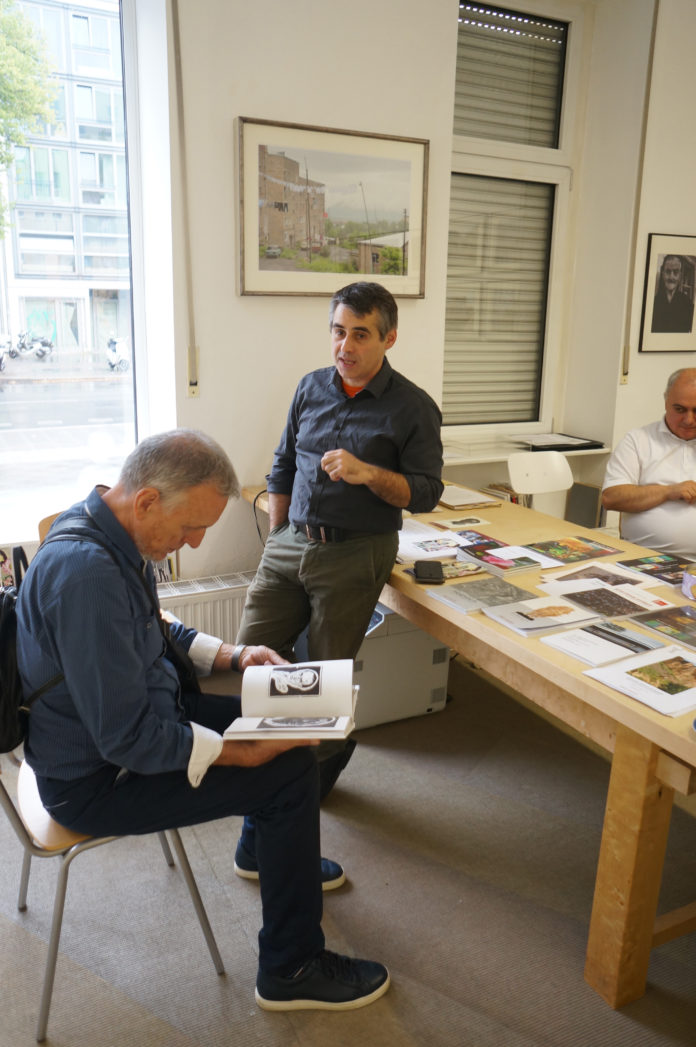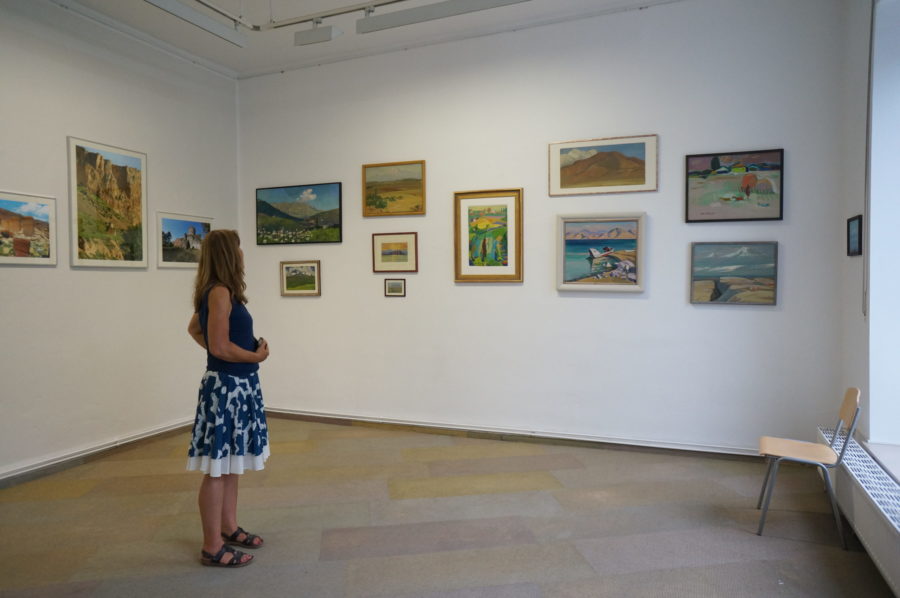
Former German Ambassador to Armenia
Hans Jochen-Schmidt (seated) and Archi Galentz
Art Is More Powerful than War
by Muriel Mirak-Weissbach
BERLIN, SEPTEMBER 3, 2020 — When Azerbaijan attacked the Tavush region in July, Armenians everywhere responded with protest demonstrations. In Berlin, as reported in this newspaper, several cultural associations came together to organize an artistic response, with an exhibition that opened on August 9 and ended on August 30. Hosted by the Wolf & Galenz Gallery in Berlin, it was entitled, “Armenia: Grace and Violence. Images of Landscapes and Traces of War.”
Artist and curator Archi Galentz told guests at the vernissage that the exhibition had come as a spontaneous reaction to the renewed outbreak of violence. The initiative is a cooperative effort between his gallery, the Association of the European and Armenian Experts e.V. (AEAE) and the Tavush Spiritual Revival Foundation.
Mikayel Minasyan, chairman of the Board of the AEAE, greeted the visitors, and introduced them to the contrasting themes presented in the works on display. On the one hand, magnificent Armenian landscapes adorned with historic architectural monuments; on the other, ravages of war. Here it is not only the scenes of the recent conflict that are evoked, but also war zones in 2016. In the violent four-day war, Minasyan said, both sides suffered massive casualties. “What we want to do with this exhibition,” he said, “is to show what war destroys and what peace offers.”
On one wall Minasyan pointed to the breathtaking Armenian landscapes, on another, the photographs of monuments of Armenian architectural treasures, churches, monasteries and Khachkars. Both expressions of beauty stand in stark contrast to the devastation and suffering in the war zone, depicted also in images of internalized horror.
Not long after the conflict was rekindled in July, Minasyan recalled, a massive explosion obliterated large parts of Beirut. The Armenian quarter was also hit, leading to 13 deaths, more than 100 wounded and 200 missing.
“After the Corona pandemic,” he noted, “there came one crisis after the other,” he noted.
The landscape paintings and drawings, that come from private collections in Berlin, include the works of Mher Abeghyan, Mariam Aslamazyan, Seda Bekaryan, Hakob Hakobyan, Khachatur Jessayan, Harutyun and Armine Kalentz, Vanik Sharanbeyan, Henrikh Siravyan, A. Karpatyan, Albert Tzovyan and Hovhannes Zardaryan.
Renowned photographer Zaven Sargsyan, founder and director of the Paradjanov Museum in Yerevan, has on display photographs of historic church architecture, including the 13th-century Khoranashat monastery in the Tavush region. Traces of war there may be seen in the photographs from 2016 and from this summer, made available for the exhibition by the Tavush Spiritual Revival Foundation. Among the artists featured are Silvina Der Meguerditchian, David Banukyan, Harutyun Chobanyan, Karen Minasyan and others.
Following Minasyan’s greetings, violinist Davit Khachatryan played two solo pieces by Komitas, and Father Yeghishe Archimandrite Avetisyan concluded the event with the Hayr Mer, and a blessing. Among the honored guests were the third Secretary of the Armenian Embassy Lusine Sargsyan and the Counselor Sedrak Davtyan.
The month-long exhibition was a success, not only in terms of numbers of visitors; the message it sent was a powerful moral statement. In the face of aggression and violence, war and destruction, one must not respond in kind, but rather take the high road. News of the exhibition appeared in the Armenian press.

Some Armenian landscapes on display
And it must have reached Azerbaijan as well. But the message seems to have fallen on deaf ears there. On August 19, Wolf & Galentz received a letter by email from Baku that denounced the exhibition as “a provocation” by the Armenian community in Germany because of the use of “Artsakh Republic.” It argued that designating Karabakh as Armenian constituted a violation of international law. “We, people of Azerbaijan,” it read, “want you to react and to stop exhibiting aggression and violation of human rights.” Curiously, the person speaking in the name of the people, identified himself as an engineering student at the Process Automation Engineering Department of the Baku Higher Oil School. The organizers of the exhibition are looking into the matter.
Whatever the background, whoever the person or agency behind the letter, the nature of the reaction invites reflection on the enduring conflict, not so much on its territorial, political and geopolitical dimensions, but on the moral, intellectual and cultural aspects. It brought to my mind the story of the Djulfa cemetery in Nakhichevan, where Azerbaijani forces have systematically destroyed thousands of ancient Khachkars over the decades, and, in answer to international outcries, denied that Armenians had ever inhabited the region.
The exhibition at Wolf & Galentz continued, undisturbed, and received considerable public attention. Among the guests attending the closing ceremony, held as scheduled on August 30, was Hans-Jochen Schmidt, a former German ambassador to Armenia.